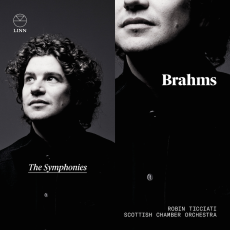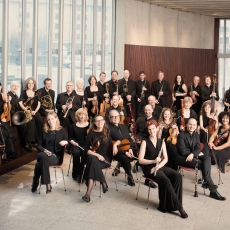Robin Ticciati & SCO - Brahms: The Symphonies (Live) - Serenade Magazine
Listening to Brahms’ complete symphony cycle is a tremendous emotional journey, and there could have been nobody better than Robin Ticciati and the Scottish Chamber Orchestra at the Edinburgh International Festival this year to take one on such a journey. This repertoire is already quite familiar to them, as they spotlighted the Brahms symphonies in their 2015/16 season, and released a landmark recording with Linn Records in 2017. One of the most delightful characteristics the SCO and Ticciati bring to Brahms’ symphonies is a clarity of sound, by virtue of both the intimacy of a smaller orchestra and Ticciati’s precise attention to nuances of detail, dynamics, balance, and tempi. Likewise, attending to the many contrasts and tensions in the symphonies was a remarkable feat.
Speaking of contrasts, the programme, split over two days, presented the First and Third symphonies together and then the Second and Fourth the day after. This emphasised the striking difference in a work about heroic struggle against turmoil and tragedy in the First Symphony with the subtlety and idyllic lyricism of the Third. The orchestra, particularly with the majestic brass section, gave the First Symphony a grand scale, yet they made their presence felt without imposing on or overwhelming the delicate textures of the smaller string sections. Speaking at an interview at the start of the 2015/16 season, he described his meticulous study into the archives of Brahms’ papers. He noted that Brahms noted the famous theme from his first symphony in a postcard to Clara Schumann, along with the inscription ‘Hoch auf’m Berg, tief im Tal, grüß’ ich dich vieltausendmal!’ (translated to ‘High on the mountains, deep in the valleys, I greet you many thousand times!’). Ticciati emphasised this speech-like rhythm and intonation in his and the SCO’s rendition of the Clara theme in the fourth movement.
For the Third Symphony, the flutes and bassoons sang with a fine voice in developing the main theme of the first movement, sensitive to the tentativeness of the middle note in the FAF motto. Ticciati and the SCO’s meticulousness gave the pastoral imagery in the second and third movements such lushness that it was possible to get lost within Brahms’ rich orchestration. As this was one of Brahms’ subtlest pieces, with each movement ending quietly rather than with roof-raising bombast, my only wish was that Ticciati held the silence at the conclusion of the piece a few moments longer to allow for its richness and complexity to sink in. However, the premature applause of an overly receptive audience at the Edinburgh Festival is perhaps not conducive to this.
While exploring the joyous, sunnier side of Brahms in their performance of the Second Symphony, the strings gave the first movement a rich, full-bodied sound with a precisely judged vibrato, and the flutes and bassoons continued to be in exquisite voice on the second day. They gave the elegiac themes of the second movement and the pastoral melodies in the third a rich, poetic expression. They brought to the finale an inspired burst of energy tempered with a precise sense of balance, as the brass marched boldly through rustling string textures without once trampling even the slightest of detail. The triumphant blaze of glory with which they concluded the second symphony was unparalleled throughout their performances.
Their performance of the Brahms symphonies all came together in the Fourth. From the beginning, the Orchestra emphasised made the foreboding and anxiety in the first movement as it emerges gradually through each successive reiteration of the main theme, each time slightly more restless and anguished. They treated the striking contrasts of melancholy and remorse of the second movement and the radiant joy of the third with a keen attention to the details of texture and orchestral colour, and with great poise and control. Everything came to a head in the finale as the Orchestra brought out the tensions in the piece’s dialogue between a foreboding sense of morality and the joy of solace and comfort. The flute solo over the string and horn accompaniment was exquisite and poignant. This was a rendition that was deeply invested in the psychic complexities, musical richness and dramatic contrasts of Brahms’ final symphony.
Robin Ticciati has had a distinguished tenure as Principal Conductor of the SCO, capped with a celebrated farewell season where they have proven theirs was a partnership that was at the height of its powers. This was his final appearance with the Orchestra, and that he should bow out with a performance of such richness and depth showcases many of their finest qualities, and celebrates a recording which is a significant milestone in both their careers.


